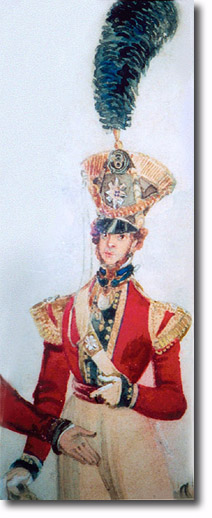|
|

 |
| This detail shows the central figure in a water-colour of a Guards group by D Alexander. In this period the uniforms worn in the British Army reached a pinnacle of dandification encouraged by King George IV who took a great interest in the appearance of his troops. The fashion was for stiff necks and small waists, tight coats and baggy trousers. And tall hats.
It was not until 1831 that the regiment took on the bearskin for all companies. Up until then the battalion and light companies wore a shako. The bell-topped shako was very high at this stage and had a two inch gold lace around the top. The black cockade in the middle had a gilt bugle badge and a gilt plume socket. The huge green plume was worn by light company officers. Other ranks had a smaller plume and no gold lace. The gold cap lines were formed into a plaited festoon across the front and hung down on the right side. The other Guards regiments simply wound the cords round the shako, hooked top and bottom. The gilt chin-scales were hooked up to the cockade. The coat is the less formal frock which is similar to that worn from the beginning of the century but with larger shoulder wings. The blue lapels are worn folded back with buttons in threes and the simple round cuff has a gold lace edge and three buttons. A gorget hangs around his neck, fastened with a blue ribbon. The sword-belt is held in place by a silk crimson sash and the belt-plate is rectangular since 1825. See Officers Belt-plate 1825-55. He wears white soft leather gloves and white summer Cossack-style trousers. |
Armed Forces | Art and Culture | Articles | Biographies | Colonies | Discussion | Glossary | Home | Library | Links | Map Room | Sources and Media | Science and Technology | Search | Student Zone | Timelines | TV & Film | Wargames